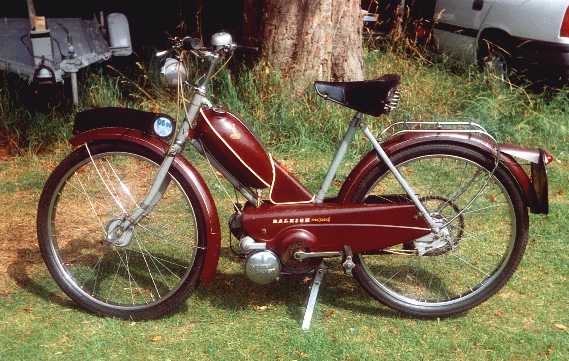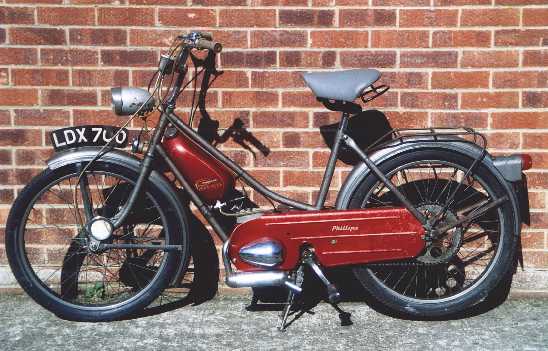 Go to the Archive
index
Go to the Archive
index
This comparison road test should have been done in 1960. Now,
40 years too late, it's Raleigh RM2 v Phillips Panda MkI in "Clash of
the Titans"

These two British built mopeds were selected for comparison test since both date around 1960, feature single speed gearing with a manual clutch and have no suspension, beyond the general specification however is where the similarities end.
The RM2 is basically a tall and elegant heavy gauge lady's cycle converted to a moped by the attachment of a factory-fitted Sturmey Archer clip-on motor built for this Raleigh application by BSA. By contrast, the Phillips utilised what probably became the last manufacturing installation of the German Rex cyclemotor which first appeared around 1950 in the form of a front mounted belt driven cycle attachment, the strong but crude Panda frame being specifically built to house the motor. Remarkably the two engines are worlds apart with the 6.2:1 compression & 1.3bhp Sturmey Archer being of overhung crank design with the cast iron barrel and deep porting arrangement laid out across the motor with old fashioned exhaust exiting on the right and carb to the left. The diminutive 9mm Amal 385 mounted to the Sturmey Archer would, on the face of it, appear to disadvantage the Raleigh, however specifications can be deceiving! The Rex engine at 6:1 compression has no bhp given but carries a 12mm Bing carb to the aluminium barrel with sleeve liner in conventional fore & aft porting layout. The crankcase cavity unusually extends all the way to the back of the motor to include lubrication of the reduction gear and its bearings by the induction gases! This results in a much reduced scavenge pressure, especially when compared to the Raleigh's arrangement. Mounted on the end of the output shaft with the sprocket inboard, the tiny 2½" Rex dry clutch is a particularly frail pull-operated instrument and typically responsible for the final demise of most machines. The Raleigh clutch unusually is not on the engine, but comprises a substantial 4½" diameter device built into the reduction belt driven flywheel which is mounted on the pedal shaft and resulting in no controllable slip action. It's in or out but there is simply no between! The Raleigh's clutch operation has a 'flip-catch' on the lever to hold neutral and conventional lever/drum operated brakes, but this means two levers on the left bar that just can't be operated at the same time. To compensate this the front brake is also linked to the back with a second cable from the lever, so applying both brakes simultaneously with one hand, unfortunately this halves the applicable pressure when using the 'front' lever alone. Braking therefore requires a special technique of using both levers up to the last second for maximum effort before having to release the left (back only) lever and engaging the clutch to keep the engine going on the throttle. Since no idle screw is fitted to the carb the motor just can't be adjusted to tick-over. The Panda has a 'grip-lock' clutch lever and a carb set-up that will allow the motor to tick-over for ever, while unfortunately the rear brake comprises a back pedal Perry Coaster hub. Marvellous for a bicycle, but with the weight and speed of a moped - utterly useless!
With the technical formalities sorted out, it's off for a ride! The Raleigh is a typically traditional cycle, tall, upright and very 'English'; it seems to have high gearing and cannot be slipped away on the clutch so requires a pedal assisted take-off. Once away it performs much better than its 1.3bhp would suggest and delivers a smart turn of speed under conditions suiting its tall drive ratio, while still strong enough to steadily climb average gradients at low revs without much need for LPA. The gearing price has to be paid somewhere though, and most other mopeds will take the advantage on the incline or particularly into a head wind where the upright stance restricts the ability of the rider to crouch. Under favourable conditions the Raleigh will really buzz up to 35+ mph and is very capable of leaving many other comparable mopeds and autocycles with this turn of speed. Such use however seems to come at a cost as the motor often becomes quirky and temperamental by quickly falling off fine tune, so requiring fanatical attention to the ignition and carb to maintain peak performance. The Phillips Panda also features a very upright riding position but immediately feels a much smaller bike with its 23" wheels, and seeming very much below you.
First impression is how much more torque the Rex motor delivers as the machine will pull cleanly away by slipping the clutch without pedal assistance, though this practice is strongly not recommended since it certainly contributes to rapid failure of the mechanism. From hereon though, the encouraging take-off evaporates into a thoroughly soggy performance with lots of four-stroking except under load, and a top speed that may only momentarily glimpse 30mph. The Rex is however stoically consistent and reliable, and never displays the Sturmey Archer's temperamental behaviour, though the Raleigh creams it on the road! The Raleigh RM2 comes over as tall, upright, and classically elegant. Light and a bit of a boneshaker, it will give the rider a hard time on rough roads and its performance to braking arrangement requires a 'thinking ahead' riding style in modern traffic. Its temperamental nature can make it irritating as a transport mount but when working well under suitable conditions makes a cracking and unusual mount for rallying. Despite its primitive and ugly frame, the Phillips Panda looks quite pleasant once the fitted panels have covered this up, while the overwhelming impression is a 'quaint novelty'. Always an easy starter under all conditions a reliable and consistent runner, though you do need time on your side to enjoy the docile character of the machine. You can always entertain yourself by constantly playing with the throttle to alternate the four-stroking with the loud induction drone as you make steady but slow progress. Despite the unspectacular performance, the dismal rear brake is still occasionally capable of injecting some stimulating moments of excitement. The sturdy cycle frame seems to plough through road bumps slightly better than the Raleigh and gives a somewhat easier ride. The Panda may make a sound selection as a transport mount but its performance is just deadly dull, the Rex made a great cyclemotor 10 years earlier but simply became eclipsed by the 'moped age'. Road tests can afford to be more frank on obsolete machines since they need necessitate no consideration of further manufacturers supply of future test models, so the NACC reader may go on to select his machine with objective knowledge. Riders have different criteria and both these machines have charm in their own right; if you still can't make a choice, then like the author, buy both! Ours is a relatively inexpensive hobby.
First published, February 2001